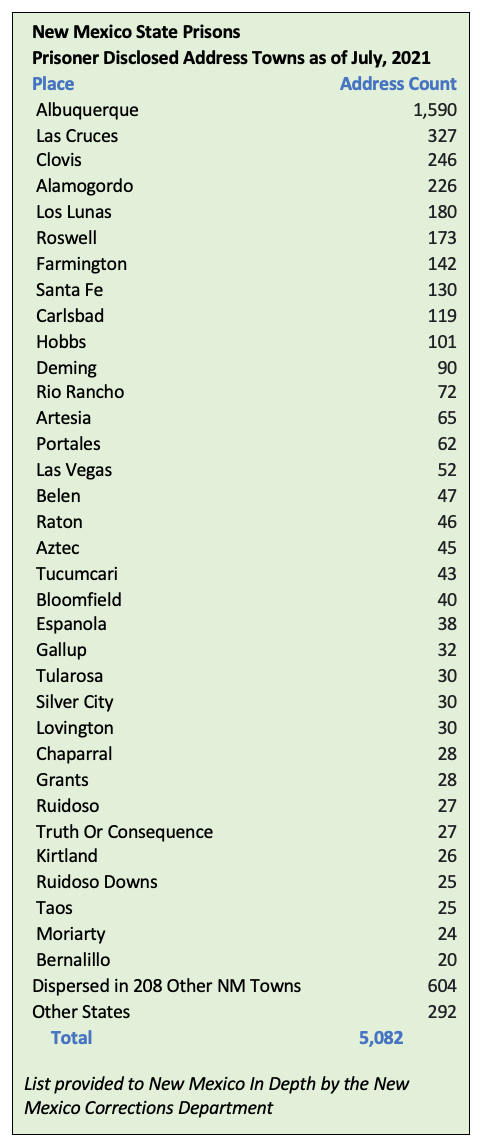While nearly a third of New Mexico’s state prisoners who disclosed where they were living prior to incarceration gave Albuquerque addresses, in the country’s once-a-decade census they’re counted as living in smaller towns and rural areas.
Roughly a quarter of New Mexico’s population lives in Albuquerque, so it’s no surprise to find a prevalence of residents from New Mexico’s largest city in the corrections system.
But corrections data obtained by New Mexico In Depth suggest the city’s voting power is diffused to smaller towns and rural areas where New Mexico’s prisons are, a practice criminal justice reform advocates refer to as “prison gerrymandering.” That’s where prison communities — often rural, and nationally, more white — benefit as prisoners from elsewhere increase their populations without being able to vote.
Advocates are pushing New Mexico to end the practice in coming months as the state’s new Citizen Redistricting Committee, and state lawmakers, participate in a once-a-decade redistricting that will shape New Mexico’s political landscape for years to come.
And at least one says the last addresses inmates give corrections officials as they enter prison could achieve that goal.
The ideal solution would be for the Corrections Department to hand over the same records it gave to New Mexico In Depth to the Citizen Redistricting Committee, said Mario Jimenez, campaign director of Common Cause New Mexico.
If the committee were to request those records, the Corrections Department “would absolutely share that with them,” spokesman Eric Harrison wrote in an email.
Samantha Osaki, an American Civil Liberties Union lawyer, said ending the practice of counting prisoners in the areas they’re imprisoned would create a more equitable redistricting process.
“Bernalillo County residents who are already suffering from the loss of parents, friends and neighbors due to mass incarceration then doubly suffer from the loss of political representation,” Osaki said.
New Mexico In Depth obtained the last addresses of 5,082 inmates after filing a records request. The Corrections Department initially refused to disclose the information but turned the records over after the New Mexico Attorney General’s office found the department had denied the request improperly.

The department created the list of addresses in mid-July. As of Monday, the state’s inmate population was 5,670. Harrison attributed the gap to the fluctuations in the prison population and that the addresses are self-disclosed at the time of intake, meaning some prisoners did not offer where they lived prior to imprisonment.
The addresses include halfway and transitional living houses and 37 “homeless” entries. And 6% are out-of-state addresses from Arizona, Texas and a few other states.
The data the agency provided came with a caveat. A disclosure attached to the records stated that “due diligence has been applied to assure the accuracy of the report data” but “due to inconsistencies and mistakes over decades of data entry…it is virtually impossible to conclude that all of these data are entirely correct.”
Data collection has long been an issue in New Mexico. For example, it’s unclear what the exact racial impacts of prison gerrymandering are in New Mexico because the state doesn’t adequately track the race or ethnicity of prisoners. Advocates say that nationally a significant portion of prisoners from urban areas who augment populations of smaller, more rural areas during the census are people of color.
The data show the great majority of New Mexico’s prisoner addresses — 84% — aren’t from the state’s prison towns; 31% are in Albuquerque, which doesn’t have a prison.
All of New Mexico’s prison towns have grown from an influx of prisoners. Incarcerated individuals compose substantial portions of local populations in some New Mexico communities with prisons. In one, more than two of every 10 residents are behind bars; and in another more than one in 10 residents are. But only a handful of people in state prisons disclosed living in these towns before incarceration.
Santa Rosa, host to Guadalupe County Correctional Center, has a total population of 2,850 and an incarcerated population of 585 as of the 2020 Census, meaning the town is 20.5% incarcerated. According to data from the Corrections Department, there are five state prison inmates with Santa Rosa addresses.
Clayton, host to Northeast New Mexico Correctional Facility, has a total population of 2,643 with 15.5% incarcerated. There are six state prison inmates with Clayton addresses.
Grants, which hosts both Western New Mexico Correctional Facility and Northwest New Mexico Correctional Center, is about 7.7% incarcerated, with 871 inmates between the two prisons. There are 28 inmates incarcerated in state prisons with Grants addresses.
In Hobbs, home to the state’s largest prison, prisoners account for 3% of the population. There are 101 prisoners who listed Hobbs addresses, which is a little less than 10% of the size of the prison population.
A number of other prisons are located just outside city or town limits in unincorporated areas of counties.
In addition to transferring political power away from non-prison towns, prison populations can distort political power within communities if city leaders don’t ensure political maps are drawn in a way that accounts for prisoners who are ineligible to vote. That’s because if prisoners are included in the local population when drawing local political district maps, a smaller group of residents is able to elect local officials in the prison district than in other districts.
The ideal solution, advocates say, would be for the Census Bureau to count inmates as residents of their home communities. In the absence of that change, states can enact laws ending the practice, as a number have done in recent years.
New Mexico doesn’t have a law addressing how to avoid the greater political power prison districts hold. But advocates say the state could avoid concentrating prison populations within a few districts by either counting prisoners at their last known address, spreading the prison population evenly among districts, or not using prisoners in counts for political representation, at all.
The newly-formed Citizen Redistricting Committee is in the process of drafting district map proposals, which are due to the Legislature by October 30, and will hold several public meetings in the next month and a half. State legislators will adopt one of the committee’s proposals or develop new ones.
“The CRC has discussed the concern about prison gerrymandering during a few meetings,” committee Chair Edward Chávez wrote in an email. “We do recognize the issue and believe it is a legitimate concern … We do not have the last known addresses for individuals prior to their incarceration on Census Day. We have not asked any of the jails or prisons for the data and do not know if they would have or share the data.”
Jimenez, of Common Cause New Mexico, called for an end of prison gerrymandering at the August 10 meeting of the Legislature’s Courts, Corrections and Justice Committee, during which the Citizen Redistricting Committee gave an update.
Prison gerrymandering, Jimenez told the legislative committee, is an “injustice not only to incarcerated people but to all New Mexicans.”



















